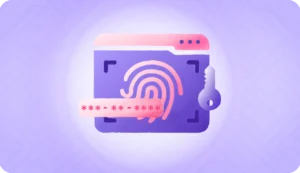TL;DR – NFC meaning in identity verification
- NFC meaning: Near Field Communication (NFC) is a short-range wireless technology that enables two devices to exchange data when held a few centimetres apart.
- NFC powers tap-to-pay cards, mobile wallets, transit systems, access cards, IoT wearables, and smart posters.
- In identity verification (IDV), NFC reads secure chips embedded in e-passports and government IDs to retrieve authoritative, cryptographically protected data.
- NFC-based IDV is faster, more secure, and far more fraud-resistant than visual or OCR-only document checks.
- For banks, fintechs, NBFCs, payments companies, and lenders, NFC unlocks high-trust onboarding, reduces manual review burden, and strengthens AML/KYC compliance.
Introduction
If you have ever tapped your phone or card to pay at a terminal, you have already used NFC, even if you never stopped to ask what NFC actually means.
Near Field Communication (NFC) is a short-range wireless communication technology that allows two devices to exchange data when they are held very close together. It is the invisible layer behind contactless payments, metro cards, access badges, wearables, and more. Because NFC works only at close range and can talk to secure chips embedded in documents and devices, it has become a powerful building block for digital identity.
In the context of KYC and identity verification, NFC goes a step further. Instead of just reading a printed ID image with a camera, NFC lets you talk directly to the secure chip inside an e-passport or NFC-enabled ID. That chip contains authoritative data and a biometric photo issued and cryptographically signed by a government or trusted authority. When you pair this with a live selfie, liveness detection, and risk checks, you get an onboarding flow that is not only smoother for users but also significantly harder for fraudsters to bypass.
In this article, we will break down NFC meaning, how the technology works, and how NFC-based identity verification fits into modern KYC, AML, and fraud-prevention strategies. We will also look at practical use cases, UX considerations, and what BFSI companies should keep in mind when designing NFC-powered onboarding journeys.
NFC meaning: What is Near Field Communication?
Near Field Communication (NFC) is a wireless communication technology that operates at 13.56 MHz and enables secure data exchange over very short ranges (usually under 4 cm). It evolved from the broader family of Radio Frequency Identification (RFID) technologies but adds faster, more controlled, and more secure device-to-device interactions.
NFC is designed for intent-based interactions: the user needs to bring two devices extremely close or tap them together. This intentional proximity is what makes NFC ideal for high-trust scenarios such as payments, access control, and now — identity verification.
Modern smartphones, transit cards, smart rings, and biometric national IDs rely on the same underlying NFC protocols, including standards such as ISO/IEC 14443 and ISO/IEC 18092.
How NFC technology works (for phones, cards, and ID documents)
At its core, an NFC system consists of:
- An active device (reader) — such as a payment terminal or smartphone.
- A passive device (tag or chip) — such as a metro card, ID document, or NFC sticker.
The reader generates an electromagnetic field, powering the passive device and enabling safe, short-range data exchange.
Three modes of NFC communication
NFC works in one of three standardized modes:
- Card Emulation Mode
The smartphone behaves like a contactless card. This is how mobile wallets such as Apple Pay and Google Pay work at point-of-sale terminals. - Reader/Writer Mode
A smartphone reads or writes data to NFC tags. This is used in posters, asset tracking, and IoT use cases. - Peer-to-Peer Mode
Two devices exchange small files or set up a secure channel for further communication.
These modes give NFC the versatility to support everything from simple tap-to-pay transactions to secure identity verification flows that feed into ID verification solutions.
Latest developments: Extended range and wearables
The latest NFC Forum specifications aim to extend usable range beyond today’s few centimetres and improve performance for wearables. This is why smart rings and watches can now reliably support payments and ID interactions. For BFSI and IDV workflows, this widening range makes NFC onboarding easier and more user-friendly without compromising security.
Everyday uses of NFC (Payments, transit, access, and more)
NFC has become universal because it solves multiple everyday use cases with unmatched simplicity.
Contactless payments
Tap-to-pay is the most recognized NFC application. Whether it is a mobile wallet or a contactless card, NFC ensures fast, secure transactions without swiping or inserting cards. Behind the scenes, AML solutions and risk engines often monitor these transactions for suspicious patterns.
Transit and mobility
Transit cards globally — and in India through initiatives like the National Common Mobility Card (NCMC) and RuPay contactless cards — use NFC to enable quick gate access, metro rides, bus entry, and toll payments.
Access control
Many enterprises and residential buildings use NFC-based badges or smartphone-based access systems to eliminate physical keys. Tapping a card or phone against a reader controls entry in a convenient but secure way.
NFC tags in advertising and IoT
Interactive posters, event tickets, product packaging, and IoT devices use NFC tags to deliver coupons, open apps, provide instructions, or trigger automated workflows when a user taps their phone.
Peer-to-peer and device pairing
Some devices use NFC to share files, URLs, or initiate Bluetooth pairing with a simple tap, simplifying what would otherwise be a multi-step process.
NFC in Indian payments and mobility
India’s rapid shift to digital payments has made NFC even more relevant:
- Metro systems across cities have adopted RuPay-based contactless cards for seamless access.
- NCMC enables “One Nation, One Card” interoperability across buses, metro, parking, and retail.
- Smart wearables (rings, watches, bands) increasingly support NFC-based payments.
- UPI is expanding into tap-to-pay experiences via NFC for fast offline and contactless transactions.
As users become familiar with tapping to pay or enter transit gates, NFC-based identity verification becomes a natural extension — especially in app-based journeys for financial services and fintech onboarding.
What is NFC-based identity verification?
NFC-based identity verification uses a smartphone’s NFC reader to extract data from the secure chip embedded inside an ID document, such as:
- e-passports
- national ID smart cards
- driving licences (in many countries)
These chips store cryptographically signed personal information and a biometric reference image that are extremely difficult to counterfeit or alter. This data then feeds into modern digital identity verification workflows.
Why NFC matters for KYC and digital onboarding
Traditional onboarding methods have limitations:
- OCR can misread fields or fail on low-quality photos.
- Manual document checks are slow, subjective, and expensive.
- Fraudsters increasingly use high-quality forgeries and AI-generated IDs.
NFC overcomes these challenges by enabling:
- Trustworthy document authenticity — Chip signatures prevent cloning, tampering, or alteration. If the document has been modified, the digital signature fails validation.
- Reliable data extraction — Data pulled directly from the chip is exact and issuer-provided, with no human error or image-based misreads.
- Stronger fraud resistance — When combined with face authentication, selfie verification, and liveness checks, NFC helps stop deepfake attempts, synthetic IDs, and impersonation.
- Faster UX and lower drop-offs — A two- or three-second chip read replaces long forms and repeated attempts to capture a clear photo.
For BFSI organizations, NFC-based verification creates a high-assurance identity layer that strengthens regulatory compliance while improving user conversion.
What information lives inside NFC-enabled ID chips?
While implementations vary by country, most secure chips include:
- Full name and personal details
- Date of birth and nationality
- Document number, issue date, and expiry date
- Machine Readable Zone (MRZ) data
- Biometric photo stored in a secure, signed format
- Security keys used for verifying authenticity
These fields are protected through public key infrastructure (PKI). When scanned, the chip confirms that:
- the document is genuine,
- the data has not been altered, and
- the chip belongs to the issuing authority.
This is why NFC is becoming a global standard for high-trust onboarding flows, especially when integrated with platforms such as HyperVerge ONE.
How does NFC-based verification work? (End-to-end process)
NFC-based identity verification is a state-of-the-art way to confirm someone’s identity using secure data stored in electronic identification documents. This method uses Near Field Communication technology to read and authenticate information embedded within chips found in modern passports, national ID cards, and driver’s licenses.
Traditional verification methods rely on manual inspection or optical character recognition (OCR). NFC verification works differently by extracting data directly from the secure chip. The system becomes virtually tamper-proof because the chip contains digitally signed information that’s nowhere near easy to forge or manipulate .
User journey
The typical journey in a fintech, bank, or lending app looks like this:
- The app asks the user to scan their ID document.
- The user taps the ID against their phone to initiate an NFC read.
- The app reads the secure chip via NFC and extracts key fields.
- The backend verifies the chip’s authenticity and signatures.
- The user performs selfie capture and liveness detection.
- The system matches the chip’s biometric template with the live selfie.
- AML, PEP, sanctions, device-risk, and behavioural checks are run.
- A decision is issued in seconds, not hours.
The power of this approach comes from its requirement of the physical document: you can’t simply present a digital copy or photo. This creates an extra security layer that reduces identity fraud risk by a lot.
System architecture
A modern NFC IDV system consists of:
- Device layer
Smartphone hardware and OS NFC APIs (for example, Android’s NFC adapter) establish a secure session with the chip, often using protocols such as PACE/BAC. - Backend layer
Server components validate digital signatures using public keys provided by the issuing authority, compare chip data with printed document fields, perform biometric face matching, and connect to AML screening systems.
Compliance and data protection
NFC-based verification helps meet:
- KYC base and enhanced verification requirements, by providing a strong, auditable identity proof.
- AML and fraud-prevention obligations, through higher-quality data and lower forgery risk.
- Data accuracy and integrity standards, as data is sourced directly from government-issued chips.
- Data protection regulations, when implemented with explicit consent, purpose limitation, and data minimisation.
Why NFC matters for KYC, AML, and fraud prevention
NFC verification gives substantial advantages to businesses dealing with KYC requirements and AML regulations. Money launderers want to turn “dirty money” into “clean money” through complex schemes. Strong identity verification is a vital first line of defence.
NFC technology stands out because it:
- Eliminates manual data entry errors
- Provides higher-resolution document images for better analysis
- Detects sophisticated forgeries invisible to visual inspection
- Completes verification in seconds rather than minutes
- Offers cryptographic security that makes forgery extraordinarily difficult
The number of NFC-enabled devices worldwide will reach an estimated 1.6 billion by 2024. This technology becomes more available for mainstream adoption in financial services, government applications, and other sectors that need strict identity verification.
Regulated industries face growing fraud threats, with identity fraud increasing over 40% year-over-year . NFC verification proves to be a powerful tool that balances security requirements with smooth user experiences.
Is NFC secure? Key risks and safeguards
Users often ask: Can NFC be hacked? In practice, it is extremely difficult to exploit NFC when implemented properly because of intentional short range and strong cryptographic protections.
Potential risks
- Relay attacks — Attackers attempt to trick the system into thinking a remote device is nearby. Well-designed apps mitigate this through cryptographic handshakes, biometrics, and time-bound challenges.
- Eavesdropping — The very short range (a few centimetres) makes interception highly impractical in real-life scenarios.
- Lost or stolen devices — Payments and IDV apps require biometric or PIN-based unlock before sensitive actions.
- Malicious NFC tags — Modern devices warn users before executing unknown NFC actions or opening untrusted links.
Built-in safeguards
- Short operating range and proximity requirement
- Encrypted sessions between reader and chip
- Government-grade PKI signatures on ID chips
- Secure Elements and hardware-backed keystores in smartphones
- Transaction limits and biometrics on payment apps
- Chip-level anti-cloning and anti-tampering measures
In identity verification, NFC offers one of the highest levels of document integrity assurance currently available outside of in-person checks.
Designing a high-conversion NFC IDV flow (for banks, fintechs, and lending)
A great NFC verification feature not only increases security but also dramatically improves conversion for digital onboarding journeys.
UX best practices
- Guide the tap — Show users where to place the document and where the phone’s NFC antenna is likely located.
- Provide real-time feedback — Use progress indicators, haptics, and clear error messages on failed reads.
- Pre-check device compatibility — Not all low-end Android devices have NFC; detect and branch flows accordingly.
- Offer fallback flows — Provide OCR or assisted verification only when NFC is unavailable or the document lacks a chip.
- Minimise manual data entry — Use chip data to pre-fill forms and reduce friction.
Business impact
- Fewer rejected or incomplete applications
- Lower manual review workloads
- Higher trust and better underwriting quality
- Reduced fraud losses and chargebacks
- Higher throughput for digital-only journeys
When combined with face authentication, OCR software, and Know Your Business (KYB) workflows, NFC becomes a cornerstone of end-to-end digital onboarding.
The future of NFC in digital identity and onboarding
NFC verification has become more than just an optional feature. Organizations now see it as both a regulatory requirement and their customers’ preference. Early adopters gain competitive advantages through faster and more secure onboarding processes.
The combination of NFC verification and blockchain technology creates secure, decentralized digital identities that work on multiple platforms. Users have better control over their personal information when dealing with smart cities, educational institutions, and financial services.
NFC technology serves as the foundation to verify identities securely and conveniently in our digital world.
National digital identity programmes
More countries are upgrading passports and ID cards to NFC-enabled chips, making NFC IDV increasingly standardised and interoperable across borders.
Travel, immigration, and e-gates
Border control systems worldwide already rely on NFC chips and biometric matching to automate immigration checks through e-gates.
Wearables as identity mediums
Smart rings and watches are becoming payment instruments and, over time, may also act as carriers for verified identity credentials.
AI-powered fraud detection plus NFC
NFC provides authoritative document data; AI adds behavioural, biometric, and transactional intelligence. Together, they form a multi-layered trust architecture ideal for real-time KYC and risk-based decisioning.
Offline and low-bandwidth onboarding
NFC’s short-range, device-to-document design supports onboarding in areas with limited connectivity, which is critical for rural banking and small business lending in emerging markets.
FAQs about NFC meaning and identity verification
What is the meaning of NFC in mobile phones?
In mobile phones, NFC enables the device to communicate wirelessly at close range to make payments, read ID chips, or interact with NFC tags through simple taps.
What is the full form of NFC?
NFC stands for Near Field Communication.
Is NFC safer than QR codes or magnetic stripe cards?
Yes. NFC transactions use encryption, secure elements, and cryptographic signatures, making them harder to clone or intercept than QR or magstripe-based systems.
Do all phones support NFC?
Most modern mid-range and premium Android and iOS devices have NFC built in, but some budget phones may not. Good onboarding flows detect this and route users to appropriate alternatives.
How is NFC used for KYC and identity verification?
In KYC, NFC reads the secure chip inside an ID document, extracts verified data, and compares it with a live selfie and additional risk checks to authenticate identity.
Conclusion
NFC technology has quietly become foundational to digital trust. It powers the payments we make, the transit gates we use, and increasingly — the identity verification processes that determine who can access financial services.
By enabling secure, chip-level data extraction and pairing it with AI-driven facial recognition, liveness detection, and AML monitoring, NFC gives BFSI organizations a fast, reliable, and fraud-resistant approach to onboarding. As digital banking expands, regulations evolve, and fraud grows more sophisticated, NFC-based identity verification will shift from a “nice-to-have” to a core requirement for modern compliance and customer experience.
Financial institutions that adopt NFC early will gain an edge: stronger fraud prevention, smoother user journeys, reduced manual costs, and a future-ready identity stack. Platforms like HyperVerge bring NFC, face authentication, OCR, and AML screening into a single, production-ready stack so you can ship high-assurance onboarding experiences faster.





